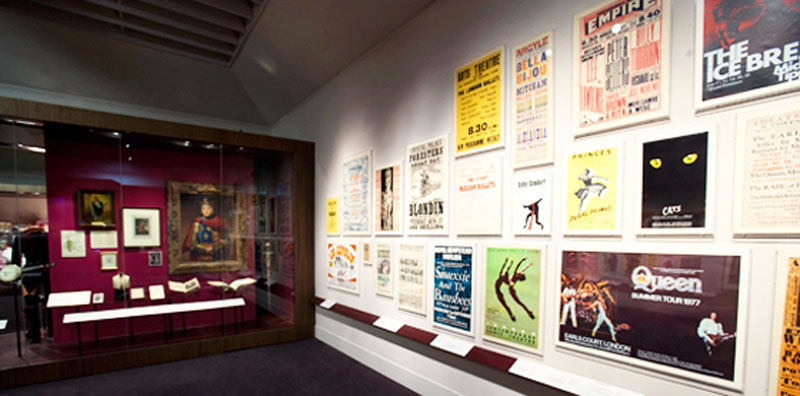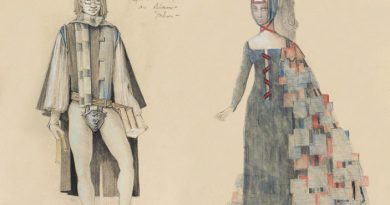Victoria and Albert Museum
Jeremy Malies in South Kensington
Debate over the fate of the Theatre Museum at Covent Garden raged for many months with ferocious claims and counter-claims exchanged by opposing parties. When it became clear that the existing building would never receive Lottery Fund assistance, a move to alternative premises became inevitable. Jeremy Malies visited the new Theatre and Performance Galleries within the main Victoria and Albert Museum site which now houses the core of the country’s theatrical heritage.
Exhibits at the galleries in South Kensington which opened in spring of this year range from a Shakespeare first folio (1623) to the Azimuth Coordinator sound system used by Pink Floyd at 1970s rock concerts. Documents cover a gamut from the Drury Lane’s licence issued at the end of Cromwell’s Protectorship to media reports on reality talent discovery shows. Footwear extends from Kylie Minogue’s Jimmy Choos to Little Titch’s winklepickers. Few would argue that live performance over the last 350 years has not been represented in all its splendour and occasional tawdriness.

Broad headings at London theatre museum
A central difference between the two venues is that while Covent Garden (which was always an outpost of the V&A) offered a chronological treatment of theatrical art forms, the new site focuses not so much on development but on what different performance modes have in common and uses broad headings such as ‘Creating’, ‘Rehearsing’, ‘Producing.’ Multi-media displays abound (though not to an extent that will overwhelm older visitors) and the experience has the dynamism of website usage where subjects are explored in a digressive manner as opposed to the linear experience of reading a book. Thus, the many playbills are displayed not to show advertising over the ages but are grouped according to graphical content and thematic approach. The displays make specific appeals for one’s attention and give little scope for the familiar complaint of museum-goers in any artistic or historical form: “My available time is coming to an end and I’m only at 1750!”
The atmosphere is immediately inclusive and I’m struck by a video loop in which Polly Teale suggests that theatre “renders visual the part of you that is usually repressed”. In the same clip, Henry Goodman argues that the aim of theatre is to provoke moments of lucidity while Michael Frayn describes the form as merely a compressed version of what happens in our everyday lives. All of this is consistent with the V&A’s goal of retaining the mystique of theatre but making it accessible by lifting the lid on technical matters to encourage a new generation of directors, set designers and lighting engineers. There is a wealth of information to accompany the exhibits but it is digestible and often appears on touch screens. The V&A authorities are aware that they can no longer expect visitors of any age to take in item descriptions from printed notices that are a foot long.
The first open-display artifact I see is a near-life-size rhino from the Royal Court’s 2007 production of Ionesco’s absurdist piece Rhinoceros. A pantomime-style object designed to be operated by two performers, it is prefigured in the action of the play by the appearance of rhinoceros heads as part of mass metamorphosis. The arrival of such a realistic creature within a framework of meta-theatricality would surely have delighted both the playwright and Orson Welles who worked with Laurence Olivier and Joan Plowright on a production of the piece in 1960.

The rhino is made of latex and will degrade within two years, there being little that staff can do to preserve him. But the ephemeral quality of such an exhibit is consistent with our transitory experience of theatre though this has in part been modified by the museum’s practice of recording live performances. My guide, curator Kate Dorney who is largely responsible for the wonderful layout and technological approach, explains that the videos – which are made at regular performances – initially met with opposition but Sir Ian McKellen recognized their value and lobbied his colleagues. Camera operators never go closer than a head-to-waist frame and the viewer is spared intimate details that would be visible from the front row of the stalls. The holdings include RSC productions, major West End musicals, pantomime and fringe theatre. While ballet and opera are often recorded for commercial release on DVD, the filming of live theatre on this scale is unique. Anybody, from a heavyweight academic or journalist to a casual theatre-goer, can make an appointment and see recordings at the museum’s reading room and repository in Blythe House, Olympia.
Dorney is at pains to dispel the myth that since theatre costumes and props are only seen from a distance, they are likely to have crude finishing, clinching her argument when she indicates a sword used by Sir Henry Irving that features engraving by Burne Jones. She is also animated when stressing that many of the artifacts carry life scars, showing me the conductor’s score from the first run of Jesus Christ Superstar and gleefully indicating stains created when over-enthusiastic scourging sprayed blood into the pit.
The curator expands on her point, explaining that exhibits here are rarely artifacts without a context but represent the circumstances surrounding productions. Thus, the prompt copy for Jonathan Pryce’s 1980 Hamlet in which the ghost of the father burbles up from within the son, has the dead king’s speeches blotted out. Similarly, an account book from the 1895 production of The Importance Of Being Earnest illustrates the effect on ticket sales of Wilde’s trial for “gross indecency” and shows the cost of placing police officers outside the St James’s Theatre. Many documents are digitized so that visitors can explore priceless manuscripts in detail.

There is no shortage of visual impact from items such as the original Minnie the Magic Piano used in Salad Days, a musical known to have made the teenage Cameron Mackintosh resolve to make his living in theatre. Dame Edna Everage’s breakfast dress is only metres away from more functional objects such as the rotating hook that allowed the early twentieth-century trapeze artist Pansy Chinery to spin above audiences suspended by her teeth, the equipment even featuring a palette fixture showing the outline of her molars and incisors. This detail is pointed out by Dorney who dwells on the physicality of live performance and the discipline that has to come with it.
Hordes of school children not only use the well-stocked dressing-up box but are also allowed to practice their manoeuvres as they assume the characters of animals from The Wind in the Willows, this being a prominent clip in the audiovisual section. However, the footage shows adult cast members from the 2005 National production putting in hard slog with no-nonsense movement coach Jane Gibson. There are mirrors everywhere for checking posture and the youngsters soon realize that it is only through sustained effort that you can inhabit a role. At the same time, visitors of school age are made to feel that they can take inspiration from anywhere and should experiment at will with make-up, scenery and effects, all of these disciplines being represented.
The collection of playbills is extensive, ranging from Restoration comedies to the first run of Look Back In Anger. Many have a satirical edge and I’m struck by the powerful design of a billboard advertising Ned Sherrin and Alistair Beaton’s The Ratepayers’ Iolanthe. At a more profound level, few people apart from the very young leave the galleries without realizing that the performing arts have never existed in a vacuum. Social change and politics are ever-present and Kate Dorney mentions that with apartheid a distant memory for some and ancient history for teenagers, it is important to remember that when John Kani and Winston Ntshona. traveled from Johannesburg to the UK as part of a Market Theatre tour, they could only leave South Africa after they were listed as Athol Fugard’s servants. Censorship, another heavy topic, is treated effectively in the galleries and there are revealing documents showing changes requested to Joe Orton’s Loot (1965) by a Lord Chamberlain in his last days of office.
One point about the galleries needs to be made forcibly. Whether you are a curious primary school pupil, a stage-struck teenager, a double-domed university lecturer or a hard-bitten theatre journalist, this new gallery space is oodles of fun.
Admission to the Theatre and Performance Galleries is free and the displays are situated on the first floor of the V&A.









